
Overview
The article titled "9 Essential Tips for Mapping User Journeys Effectively" serves as a critical guide for brands aiming to enhance their user journey mapping processes. It asserts the necessity of defining clear objectives as a foundational step. Moreover, understanding customer emotions is paramount, as it allows brands to connect on a deeper level.
Identifying pain points within the user journey is essential for improvement, while leveraging data-driven insights can significantly elevate the quality of customer experiences. These strategies not only foster engagement but also lead to improved conversion rates and heightened customer satisfaction.
Introduction
Mapping user journeys stands as a pivotal strategy for brands intent on elevating customer experiences and driving conversions. By leveraging expert insights and data-driven methodologies, companies can craft detailed experience maps that resonate profoundly with their audience, ultimately leading to heightened profitability. Nevertheless, the challenge resides in the effective identification and resolution of the pain points and emotional triggers that shape consumer behavior.
How can brands adeptly navigate this intricate landscape to not only meet but surpass customer expectations?
Parah Group: Leverage Expert Insights for User Journey Mapping
Parah Group commands attention in the realm of Conversion Rate Optimization (CRO) for direct-to-consumer brands, leveraging data-driven strategies to significantly enhance consumer experiences. Their insights into mapping user journeys are not just valuable; they are essential for brands committed to elevating client interactions and driving conversion rates.
By harnessing specialized expertise, companies can craft experience maps through mapping user journeys that resonate deeply with their target audience, ultimately leading to enhanced profitability. This strategic approach positions brands to not only meet but , fostering loyalty and maximizing financial outcomes.
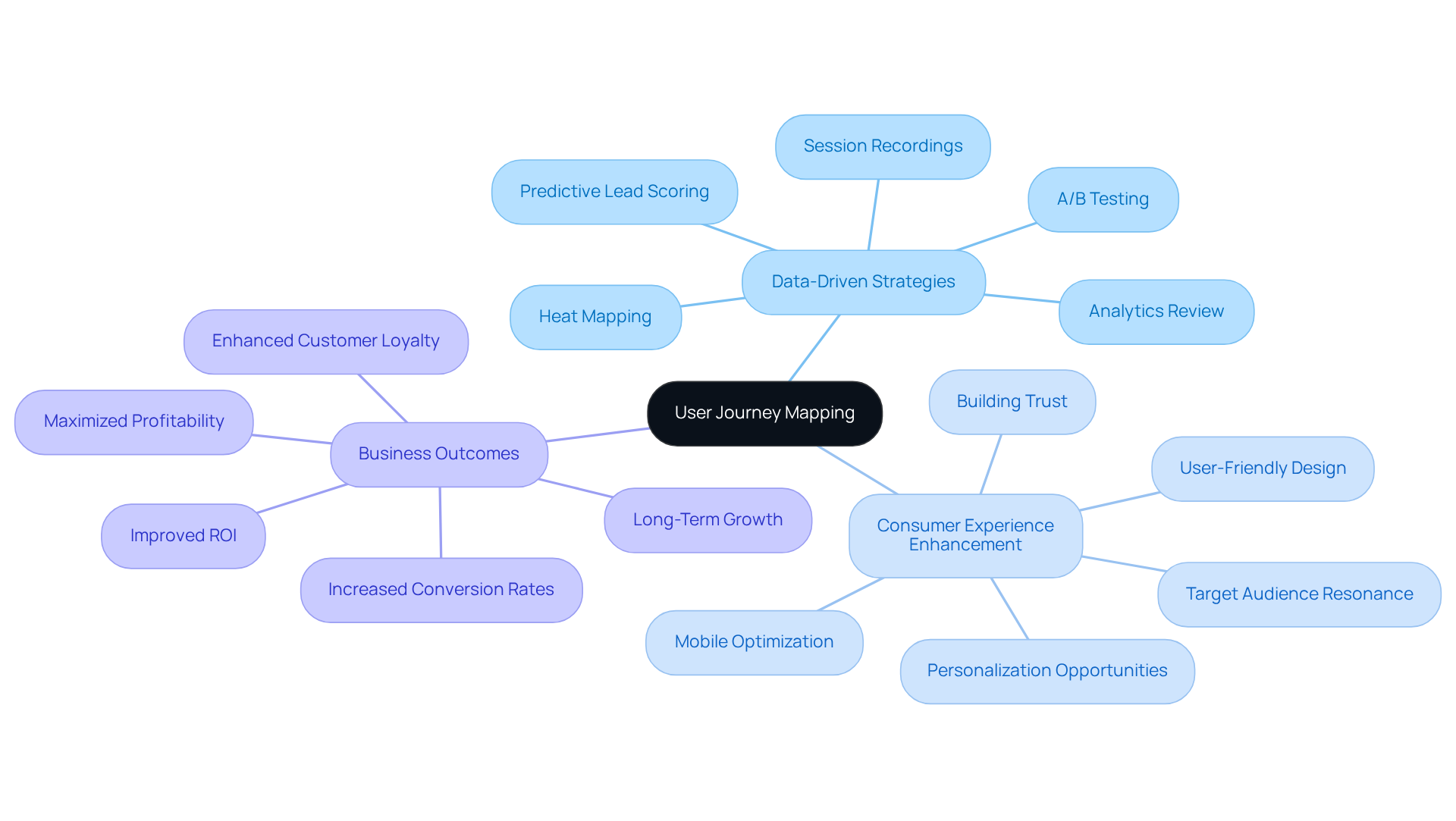
Define the Scope: Establish Clear Objectives for Mapping
Before embarking on the mapping process, it is imperative to define the scope and establish clear objectives. Identify precisely what you aim to achieve with mapping user journeys—be it improving conversion rates, enhancing client satisfaction, or pinpointing pain points. This will not only guide your research but also ensure that the insights garnered are in alignment with your overarching business goals.
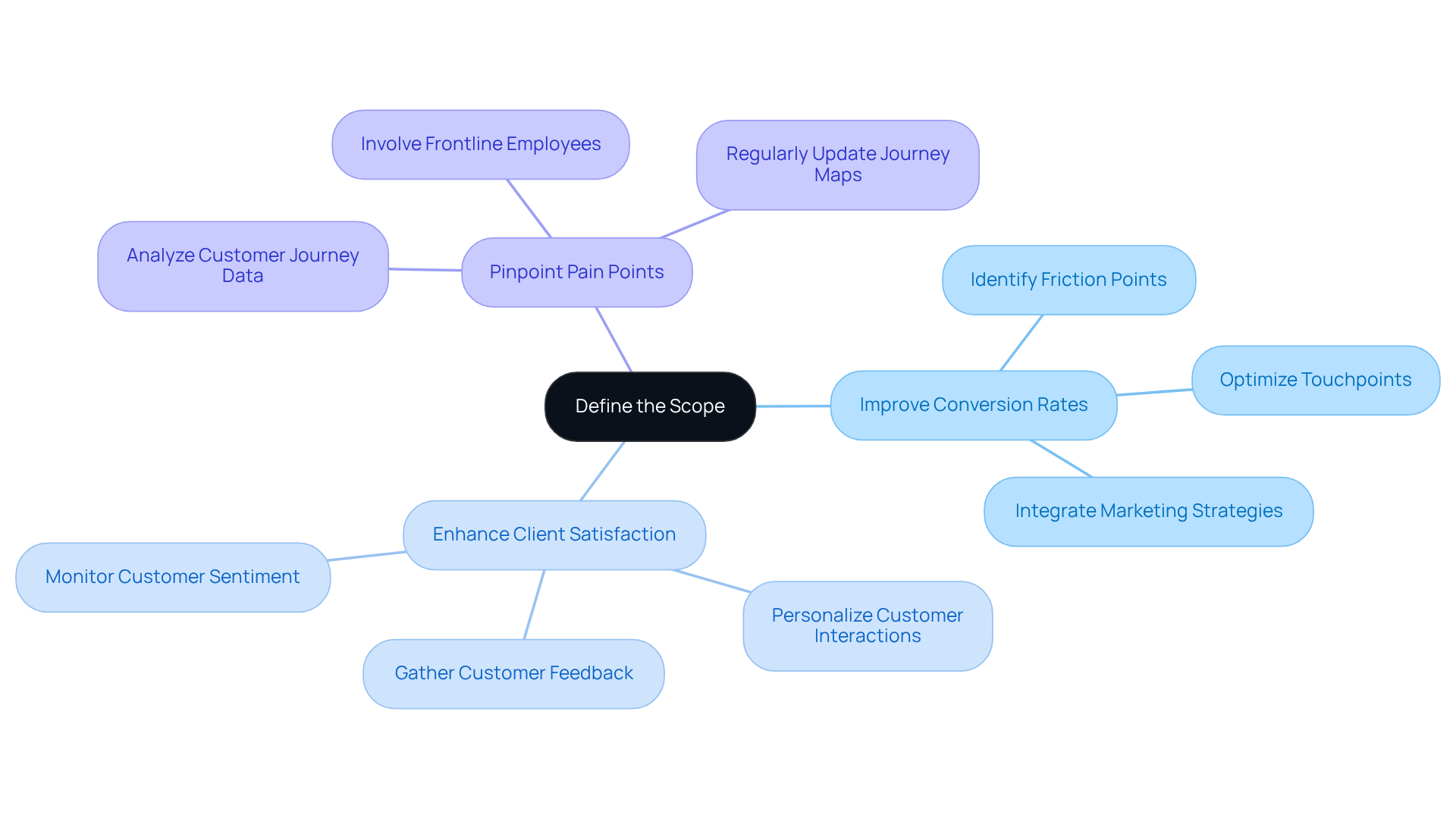
Create a Customer Back-Story: Connect with Your Audience
Developing an engaging client back-story is essential for DTC brands, particularly those attracting at least 100,000 website visitors monthly. This process involves crafting detailed personas that embody your target audience, encompassing key demographics, motivations, and the challenges they face. By understanding who your clients are and the factors influencing their decisions, you can create a path map that accurately reflects their interactions.
Psychologists stress that identifying the emotional triggers behind purchasing decisions can yield more impactful messaging. For example, Parah Group has realized a 36% increase in ROI on ads for clients by utilizing such insights.
Ultimately, a well-defined client back-story serves as a foundation for , ensuring that every interaction aligns with the genuine needs and goals of your clients while identifying challenges and enhancing the overall client experience.
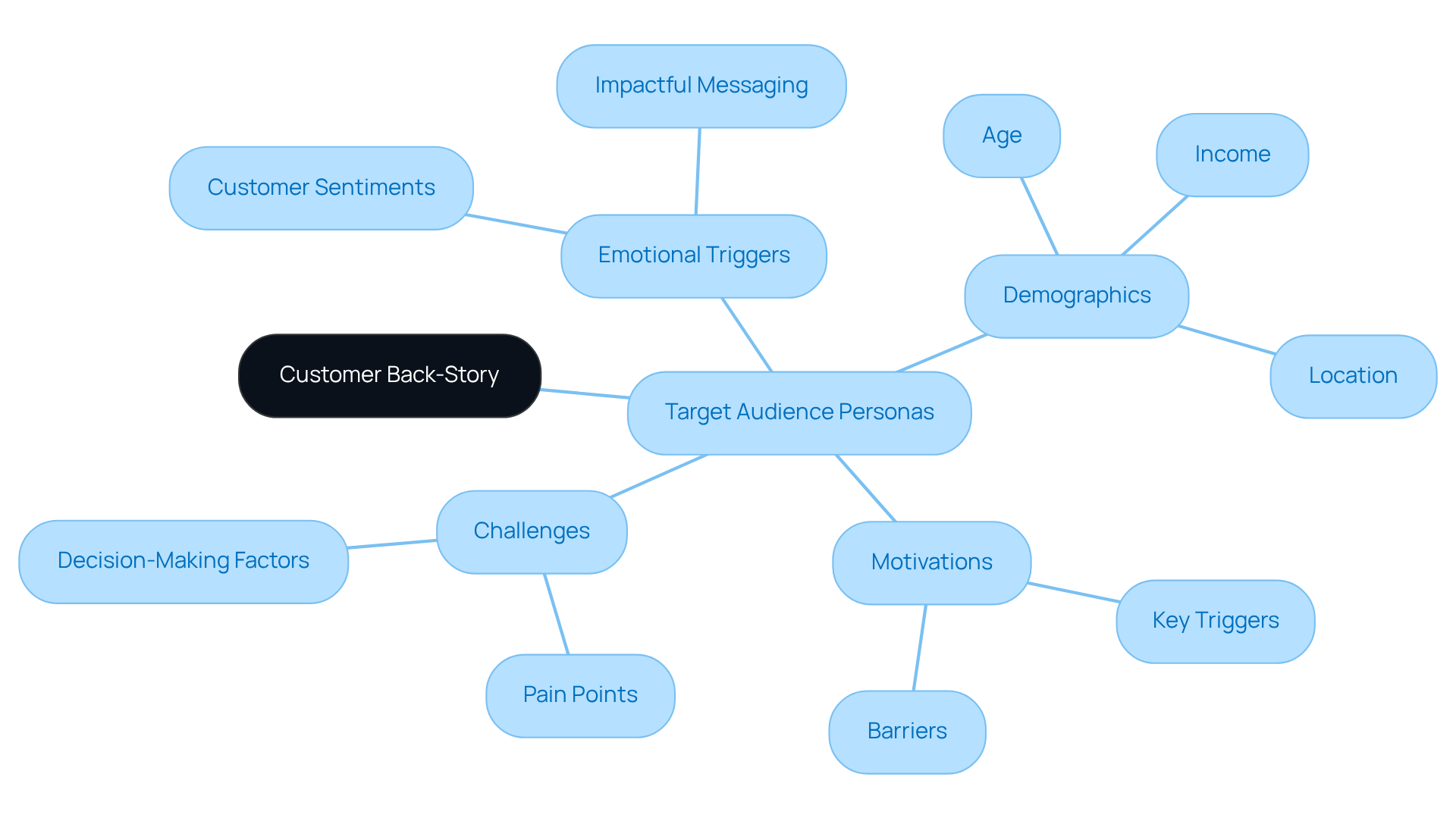
Map Customer Thoughts and Feelings: Gain Insight into Experiences
To effectively outline participant journeys, is imperative to capture not only the actions individuals take but also their thoughts and feelings at each stage. By employing qualitative research techniques, such as in-depth interviews and open-ended surveys, brands can gain profound insights into consumer emotions. These insights are essential for identifying pain points and opportunities for improvement within the client experience, as they can reveal gaps that may hinder satisfaction.
For example, understanding the reasons behind cart abandonment can inform strategies to streamline the purchasing process, ultimately leading to enhanced satisfaction and higher conversion rates. By integrating qualitative data with quantitative metrics, brands can cultivate a holistic perspective of the client experience, ensuring that every touchpoint aligns with expectations and fosters loyalty.
As noted by UX researchers, 'Qualitative insights can help fill those gaps so you can overcome future obstacles to conversion and effectively re-engage any customers who lost interest before buying.
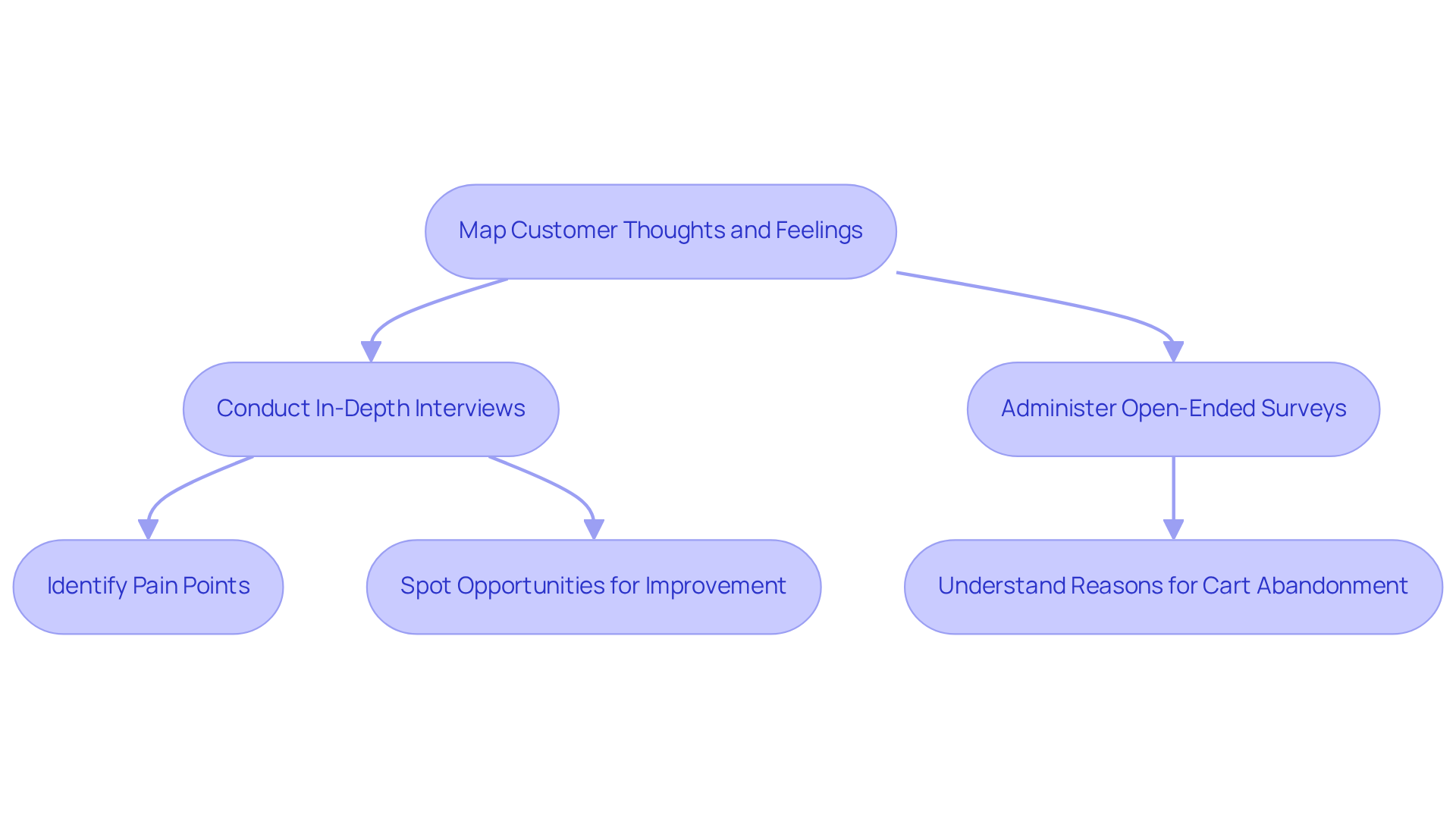
Identify Pain Points: Enhance the User Experience
Pain points represent specific challenges or frustrations individuals face during their journey. Identifying these issues necessitates a thorough analysis of feedback, usability tests, and session recordings. For instance, usability testing can reveal interaction-level pain points, such as the significant delays individuals may experience, exemplified by the three-month wait for a Peloton bike delivery appointment, which often results in confusion and frustration.
Once a comprehensive understanding of the pain points is established, prioritization based on their impact on the overall experience and the feasibility of potential solutions becomes crucial. Strategies to address these pain points may encompass:
- Simplifying processes
- Providing clear signposts
Both are vital for mapping user journeys while ensuring consistent messaging across all touchpoints. Companies like DoorDash and Spotify exemplify successful enhancements in customer experience; DoorDash has optimized food delivery, whereas Spotify has refined the music streaming concept, rendering it simpler and more accessible.
Moreover, leveraging customer feedback can significantly influence conversion rates. Research indicates a direct correlation between slow loading times and conversion rates, with 75% of visitors abandoning sites that load slowly. By focusing on user-centered design principles and employing data-informed strategies, brands can cultivate a seamless experience that not only meets but exceeds user expectations. Ultimately, grasping and is essential for nurturing long-term client relationships and driving sustainable growth.
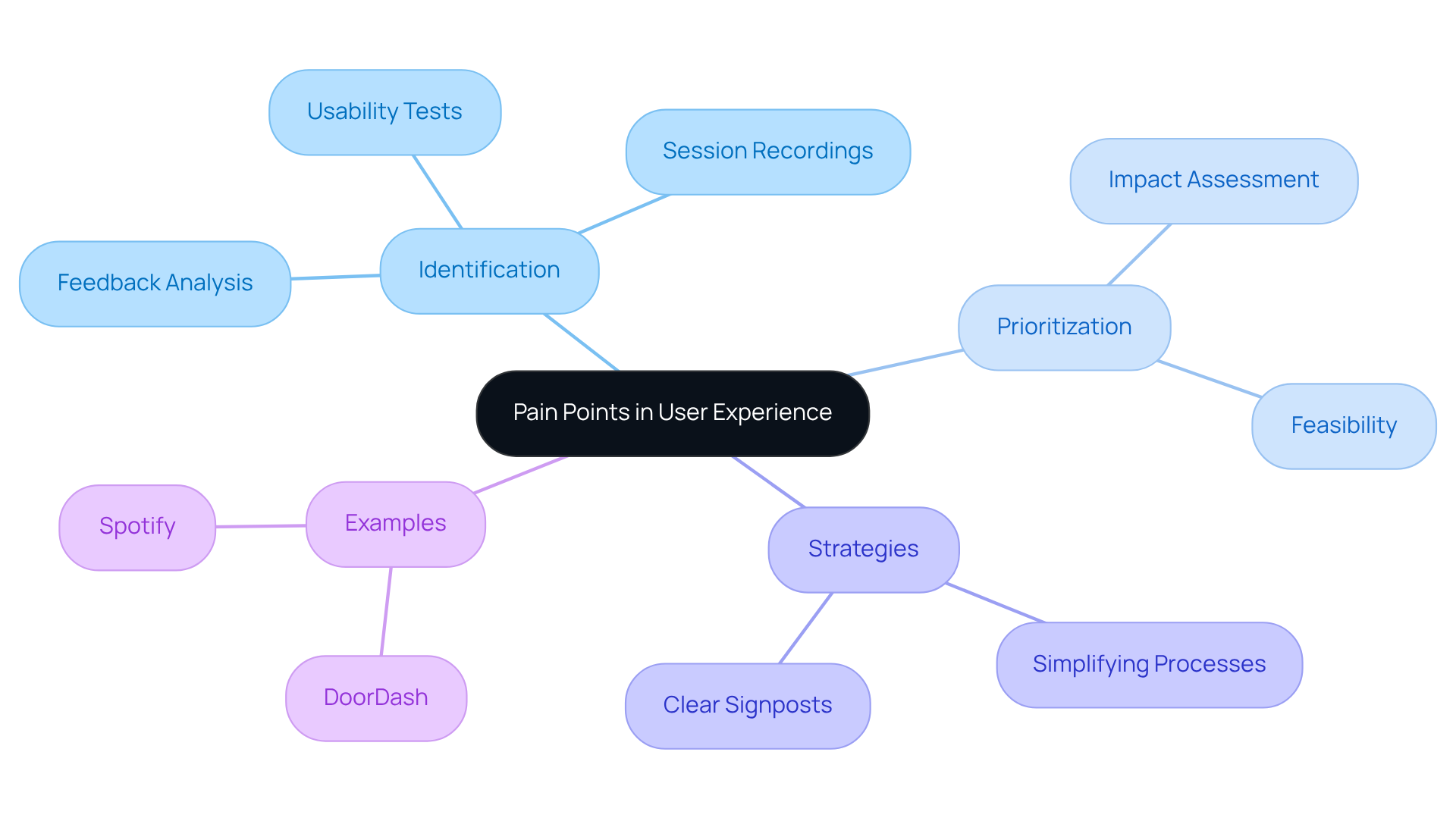
Chart a Sentiment Line: Visualize Customer Emotions
A sentiment line serves as a powerful visual tool that captures the emotions of clients throughout their journey. By mapping user journeys and emotions at each interaction, brands can identify where individuals experience positive, negative, or neutral sentiments. This visualization not only highlights the emotional terrain of the user journey but also facilitates mapping user journeys to pinpoint specific areas for enhancement.
Research from McKinsey indicates that:
- 85% of clients are inclined to purchase more following a favorable interaction.
- 70% reduce their spending after an unfavorable one.
Furthermore, with 89% of businesses competing primarily on client experience (CX), addressing emotional responses is essential for improving overall satisfaction and fostering loyalty. As UX designer Scott K. Wilder asserts, "Sentiment analysis transforms frustration into trust, data into empathy, and technology into human connection."
Understanding sentiments and mapping user journeys can lead to more , ultimately driving superior business outcomes.

Analyze the Big Picture: Evaluate Mapping Effectiveness
After developing the journey map, it is essential to step back and evaluate the effectiveness of mapping user journeys. Begin by assessing whether the objectives established at the outset are met through mapping user journeys. Look for trends and patterns in behavior, as mapping user journeys can provide vital insights for enhancement. For instance, organizations that leverage real-time insights report an 18% increase in client satisfaction and a 28% rise in engagement, underscoring the importance of data-driven insights in enhancing participant experiences.
Furthermore, a thorough examination of consumer behavior trends is especially crucial for DTC brands, which frequently face distinct challenges in mapping user journeys to enhance client interactions. By pinpointing specific touchpoints where individuals may encounter obstacles, brands can enhance the client experience through mapping user journeys and implementing focused strategies. Research indicates that is the most critical factor for success, with a score of 6.08, emphasizing the necessity of a client-centric approach.
As you analyze the mapping user journeys diagram, take into account the feedback from marketing analysts who emphasize the importance of aligning these mapping efforts with actual user behavior. This alignment not only enhances the precision of the map but also aids in mapping user journeys to foster a deeper understanding of customer needs. Consistently revisiting and validating the map against established KPIs ensures that mapping user journeys remains relevant and effective in driving business growth. Notably, only 43% of enterprises confirm their process maps with actual CRM data, highlighting the necessity of data validation in mapping user journeys. By continually refining your strategies according to behavior trends, you can create a more engaging and fulfilling experience for your clients.
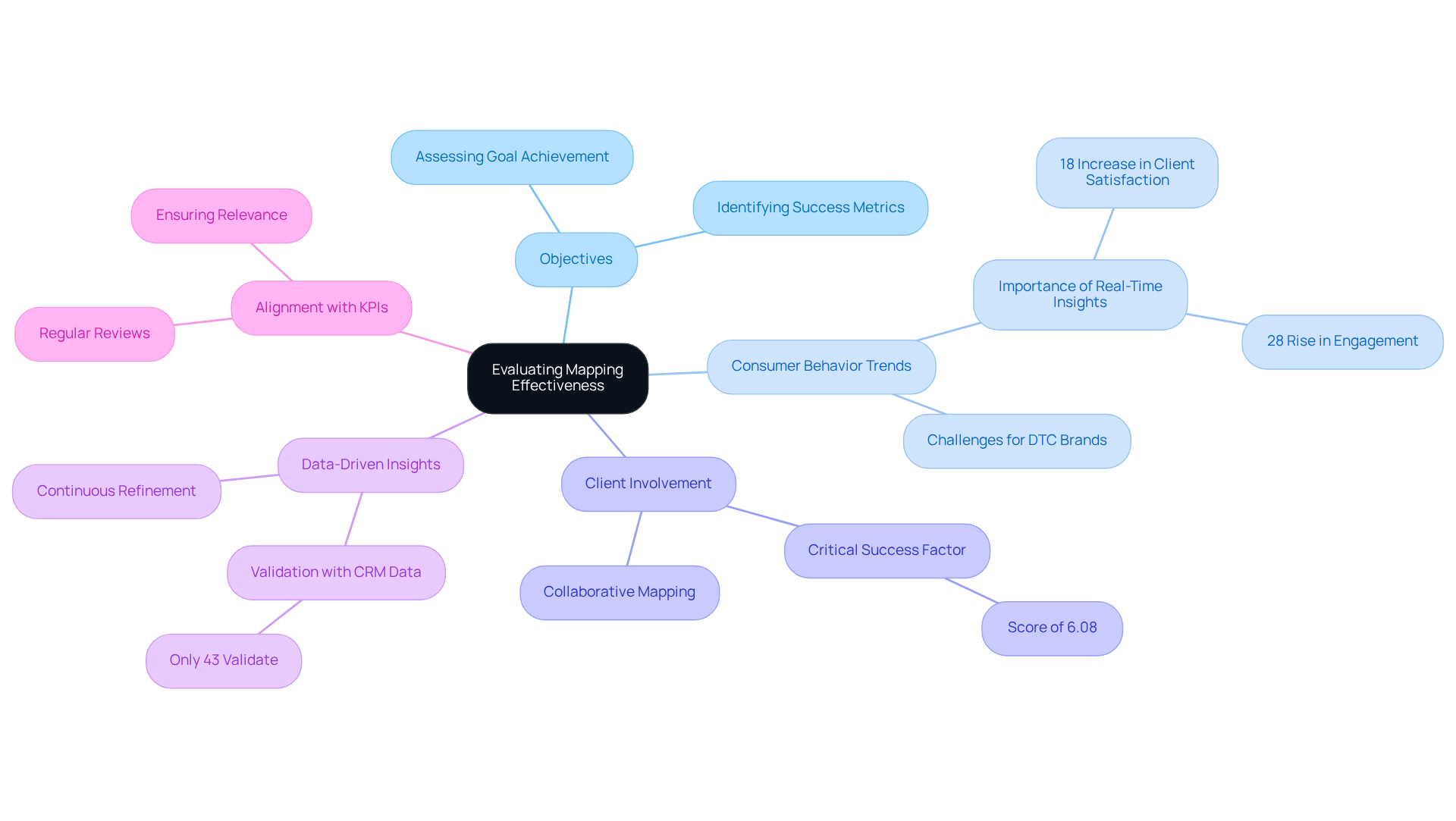
Incorporate Follow-Ups: Ensure Continuous Improvement
To ensure ongoing enhancement, it is crucial to integrate follow-ups into your process of . Schedule regular reviews of the mapping user journeys to assess their effectiveness and make necessary adjustments based on new data and insights. This iterative approach empowers businesses to remain responsive to evolving customer needs and preferences, ultimately driving superior results.
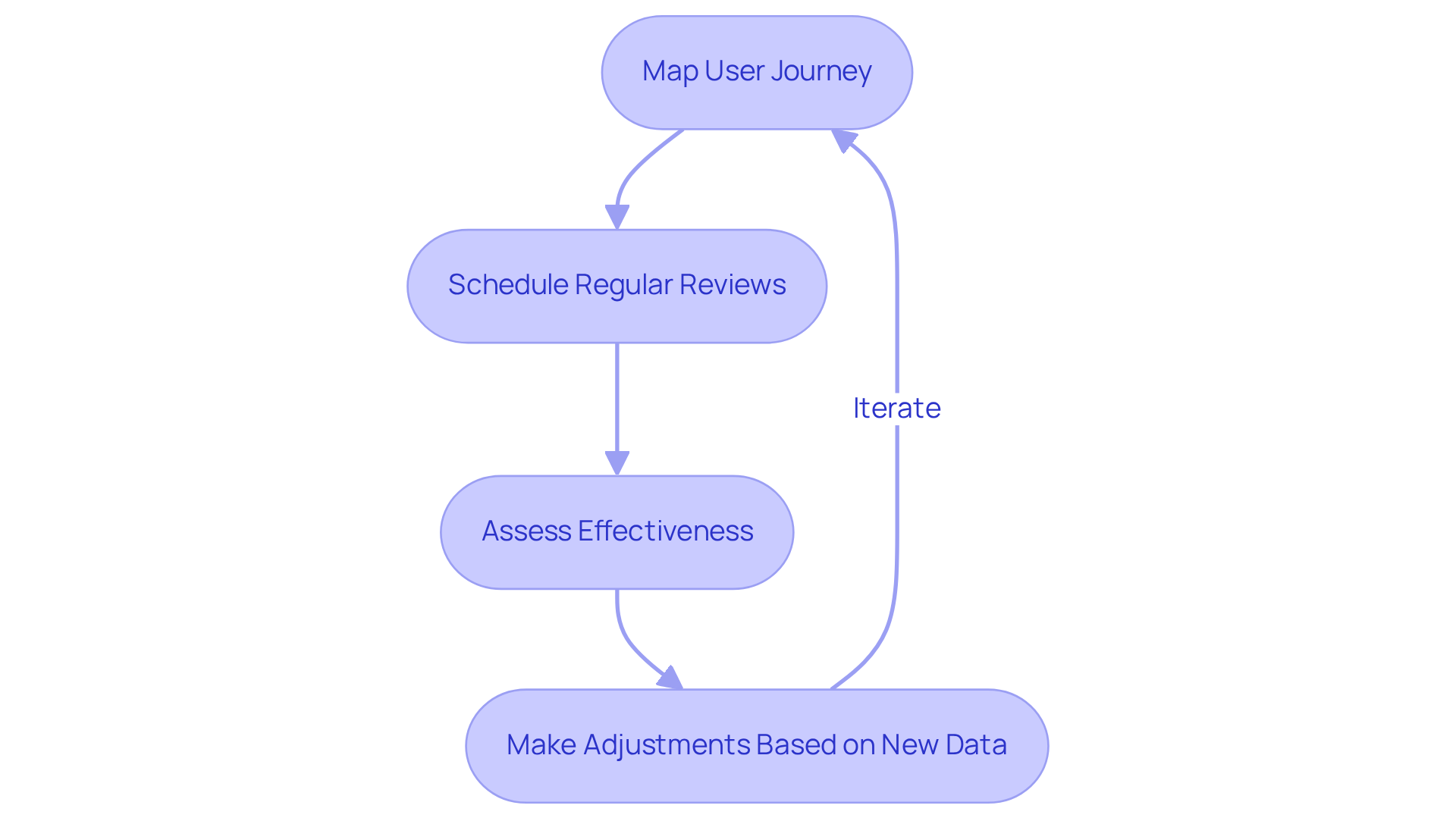
Use User Session Recordings: Gain Real-Time Insights
Session recordings serve as a powerful tool for businesses, enabling them to observe genuine interactions with their websites or applications. By analyzing these recordings, companies can identify usability issues, gain insights into consumer behavior, and pinpoint areas that are ripe for improvement.
For example, a salon business discovered that clients faced challenges during the date selector step of their online booking form, illustrating how session recordings can uncover critical friction points. This real-time analysis is essential for mapping user journeys, enabling brands to understand where individuals encounter challenges or confusion.
Usability testing has demonstrated that can prevent them from escalating into widespread problems, ultimately boosting customer satisfaction. Numerous DTC brands, such as Costa Coffee, have effectively leveraged session recordings to scrutinize consumer behavior, leading to significant enhancements in conversion rates and overall satisfaction.
Costa Coffee optimized their registration process, resulting in a 15% increase in app registrations. As noted by UX researchers, "Every drop-off or frustration conveys a narrative, and session recordings assist in revealing it."
By harnessing session recordings, businesses can revolutionize their approach to customer experience, ensuring that every interaction is meticulously optimized for success. However, it is crucial to implement session replay tools judiciously to avoid any negative impact on website performance.

Conduct Competitor Analysis: Learn from Industry Leaders
Competitor analysis is essential for mapping user journeys of individuals. By scrutinizing how rivals curate their customer experiences, brands can uncover best practices and pinpoint areas for improvement. This process entails a comprehensive evaluation of competitors' , which can inform and refine your own strategies.
For instance, analyzing direct competitors can reveal effective methods that resonate with individuals, while insights from indirect competitors can inspire innovative design strategies. Leveraging these competitive insights not only aids in crafting a more engaging experience but also positions your brand to stand out in a saturated market.
As marketing strategists underscore, mapping user journeys enables brands to identify opportunities for differentiation and enhancement, ultimately fostering greater customer satisfaction and loyalty.
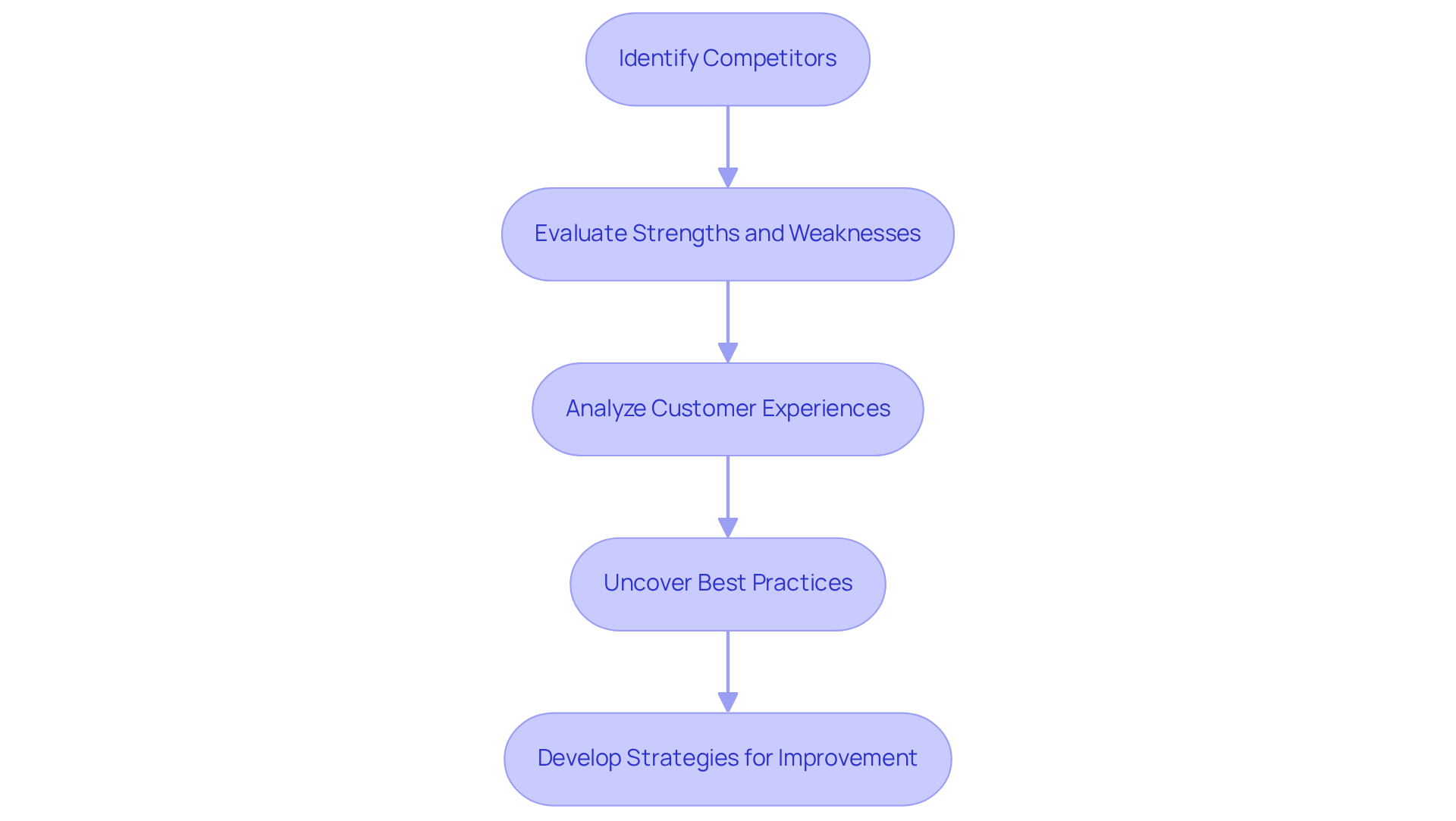
Conclusion
Mapping user journeys stands as a pivotal element for brands intent on enhancing customer experiences and driving conversion rates. By leveraging strategic insights and data-driven methodologies, companies can forge meaningful interactions that not only meet but surpass consumer expectations. The significance of grasping the intricacies of user journeys is paramount, as it directly influences customer satisfaction and loyalty.
In this article, we explored essential strategies for effective user journey mapping, including:
- The establishment of clear objectives
- The crafting of detailed customer back-stories
- The identification of pain points
- The visualization of customer emotions
Each of these components is crucial in developing a comprehensive journey map that aligns with the needs and expectations of the target audience. Furthermore, utilizing tools such as user session recordings and conducting competitor analysis can refine these strategies, ensuring brands remain competitive and responsive to evolving consumer behaviors.
Ultimately, the process of mapping user experiences is ongoing, necessitating regular evaluation and adaptation. Brands must dedicate themselves to continuous improvement by integrating feedback and insights to cultivate deeper connections with their customers. By embracing these practices, companies not only enhance user satisfaction but also drive sustainable growth within a competitive landscape. Prioritizing user journey mapping enables organizations to craft impactful experiences that resonate with their audiences and contribute to enduring success.
Frequently Asked Questions
What is the focus of Parah Group in relation to Conversion Rate Optimization (CRO)?
Parah Group focuses on leveraging data-driven strategies to enhance consumer experiences for direct-to-consumer brands, making their insights into mapping user journeys essential for driving conversion rates.
Why is mapping user journeys important for brands?
Mapping user journeys is important because it helps brands craft experience maps that resonate with their target audience, leading to improved profitability, enhanced customer loyalty, and the ability to exceed consumer expectations.
What should be done before starting the user journey mapping process?
Before starting the mapping process, it is crucial to define the scope and establish clear objectives, such as improving conversion rates, enhancing client satisfaction, or identifying pain points, to ensure the insights align with business goals.
How can brands connect with their audience when mapping user journeys?
Brands can connect with their audience by developing an engaging client back-story that includes detailed personas representing their target audience, focusing on demographics, motivations, and challenges faced by clients.
What role do emotional triggers play in the purchasing decisions of clients?
Emotional triggers play a significant role in purchasing decisions, and identifying these triggers can lead to more impactful messaging, as demonstrated by Parah Group's ability to achieve a 36% increase in ROI on ads for clients through such insights.
How does a well-defined client back-story contribute to user journey mapping?
A well-defined client back-story serves as a foundation for mapping experiences, ensuring that every interaction meets the genuine needs and goals of clients while also identifying challenges and enhancing the overall client experience.
FAQs











